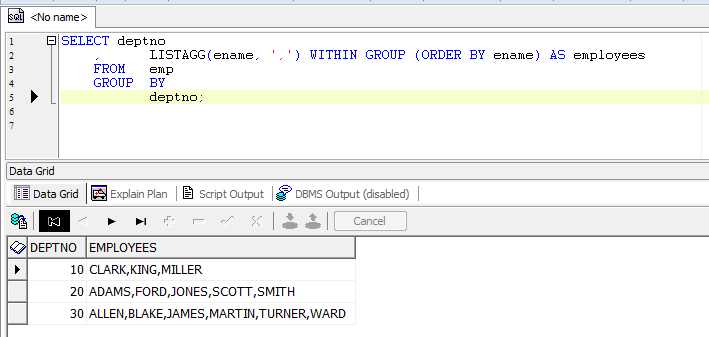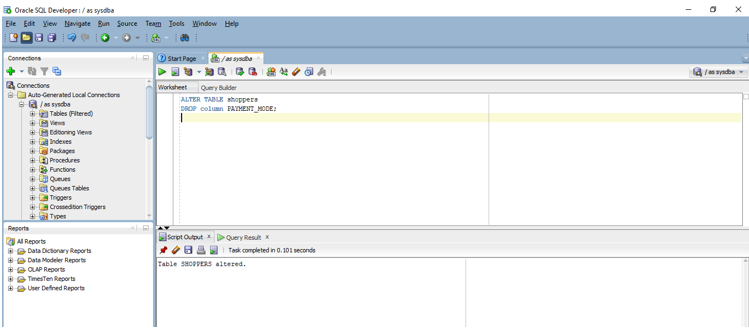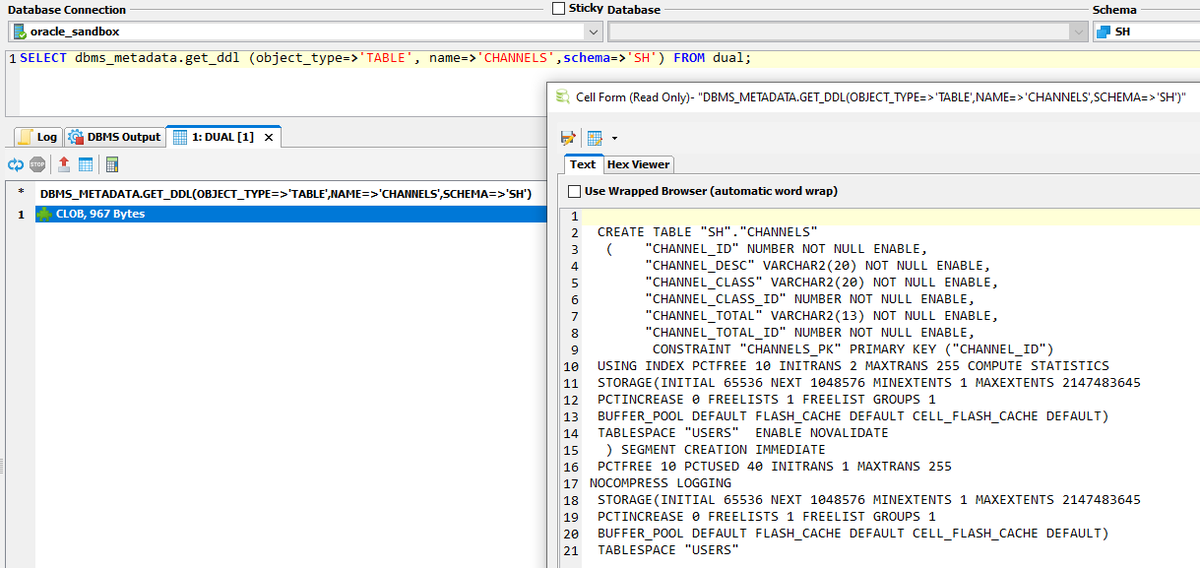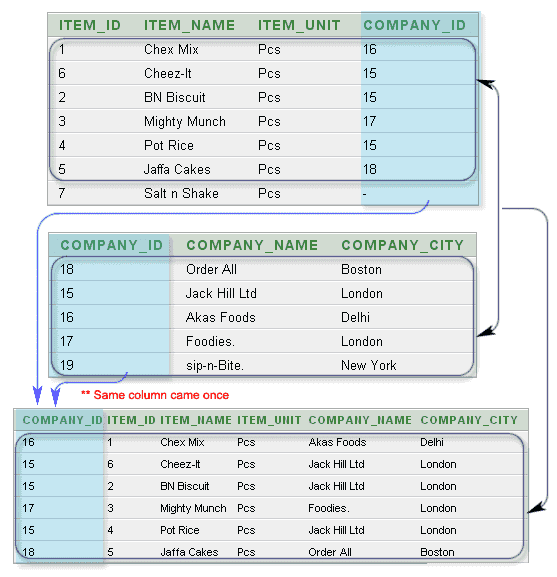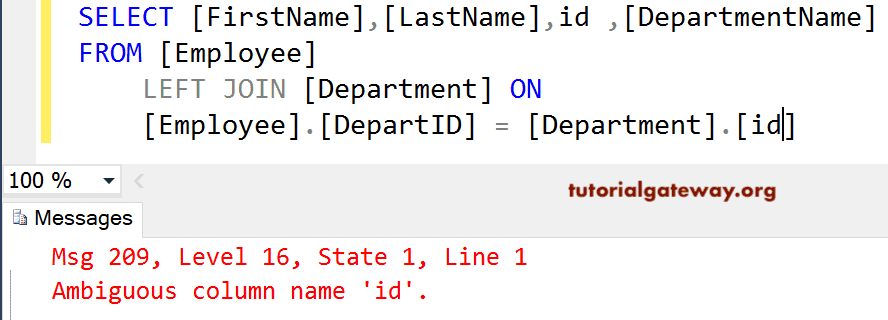All queries combined using a UNION, INTERSECT or EXCEPT operator must have an equal number of expressions in their target lists. Again, the application might actually return this error message, or might just return a generic error or no results. When the number of nulls matches the number of columns, the database returns an additional row in the result set, containing null values in each column.
The effect on the resulting HTTP response depends on the application's code. If you are lucky, you will see some additional content within the response, such as an extra row on an HTML table. Otherwise, the null values might trigger a different error, such as a NullPointerException. Worst case, the response might be indistinguishable from that which is caused by an incorrect number of nulls, making this method of determining the column count ineffective. The related tables of a large database are linked through the use of foreign and primary keys or what are often referred to as common columns.
The ability to join tables will enable you to add more meaning to the result table that is produced. For 'n' number tables to be joined in a query, minimum (n-1) join conditions are necessary. Based on the join conditions, Oracle combines the matching pair of rows and displays the one which satisfies the join condition. A query expression that corresponds, in the form of its select list, to a second query expression that follows the UNION, INTERSECT, or EXCEPT operator. The two expressions must contain the same number of output columns with compatible data types; otherwise, the two result sets can't be compared and merged. Set operations don't allow implicit conversion between different categories of data types; for more information, see Type compatibility and conversion.
In T-SQL, you summarize data by using the GROUP BY clause within an aggregate query. This clause creates groupings which are defined by a set of expressions. One row per unique combination of the expressions in the GROUP BY clause is returned, and aggregate functions such as COUNT or SUM may be used on any columns in the query.
However, if you want to group the data by multiple combinations of group by expressions, you may take one of two approaches. The first approach is to create one grouped query per combination of expressions and merge the results using the UNION ALL operator. The other approach is to use the GROUPING SETS operator along with the GROUP BY clause and define each grouping set within a single query. Operation can fail if multiple rows of the source dataset match and attempt to update the same rows of the target Delta table. According to the SQL semantics of merge, such an update operation is ambiguous as it is unclear which source row should be used to update the matched target row. You can preprocess the source table to eliminate the possibility of multiple matches.
See the Change data capture example—it preprocesses the change dataset to retain only the latest change for each key before applying that change into the target Delta table. Second, the merge_condition determines how the rows from the source table are matched to the rows from the target table. It is similar to the join condition in the join clause. Typically, you use the key columns either primary key or unique key for matching.
The database system processes the query by executing two SELECT statements first. Then, it combines two individual result sets into one and eliminates duplicate rows. To eliminate the duplicate rows, the database system sorts the combined result set by every column and scans it for the matching rows located next to one another. The UNION statement is not a JOIN statement but it is a way to combine multiple tables. The UNION statement combines the results from two tables.
The two tables must have the same number of columns and be the same data type. At this point we have deleted some teams from the Matches data table and some teams from the Unique_Teams table. We can use a UNION statement to get a list of all the teams. For best results, the tables that you combine using a union must have the same structure. That is, each table must have the same number of fields, and related fields must have matching field names and data types.
The UNION, INTERSECT, and EXCEPT set operators are used to compare and merge the results of two separate query expressions. If you want to know which website users are buyers but not sellers, you can use the EXCEPT operator to find the difference between the two lists of users. If you want to build a list of all users, regardless of role, you can use the UNION operator.
We use various data types in SQL Server to define data in a particular column appropriately. We might have requirements to concatenate data from multiple columns into a string. For example, in an Employee table, we might have first, middle and last name of an employee in different columns. The CONCAT function in SQL is a String function, which is used to merge two or more strings. The Concat service converts the Null values to an Empty string when we display the result. This function is used to concatenate two strings to make a single string.
The operator is used to link character strings and column string. As with the traditional method of equality joins, a non-equality join can be performed in a WHERE clause. In addition, the JOIN keyword can be used with the ON clause to specify relevant columns for the join. The column names returned in the result of a set operation query are the column names from the tables in the first query expression.
Select col1 + col2 as bothcols from tbl In both those cases, you end up with a single column bothcols, which contains the combined data. You may have to coerce the data type if the columns are not compatible. If one of the column is number i have experienced the oracle will think '+' as sum operator instead concatenation.
I need a way to roll-up multiple rows into one row and one column value as a means of concatenation in my SQL Server T-SQL code. I know I can roll-up multiple rows into one row usingPivot, but I need all of the data concatenated into a single column in a single row. In this tip we look at a simple approach to accomplish this.
Since NULL is convertible to every commonly used data type, using NULL maximizes the chance that the payload will succeed when the column count is correct. Please do note that the columns that you wish to merge across the multiple tables should be of compatible data types. Matt contributed this handy SQL techniques to pivot one row of several columns into a single column with several row, using the Oracle Cross join syntax. Matt notes that the Cross join "has other uses in conjunction with a WHERE clause to create triangular result sets for rolling totals etc ". To retain the duplicate rows in the result set, you use the UNION ALL operator. SQL left joins always return at least one row for the main table, referred to as the Left or Right table, and null values in the corresponding columns of the non-matching column.
To use the UNION operator, you write the dividual SELECT statements and join them by the keyword UNION. The columns returned by the SELECT statements must have the same or convertible data type, size, and be the same order. Let's start be reminding ourselves how the GROUP BY clause works.
An aggregate function takes multiple rows of data returned by a query and aggregates them into a single result row. This blog is a tutorial on how to pull data from multiple tables in SQL. In my previous blog tutorials, data was only queried from a single table at a time. With JOIN statements, data from multiple tables can be returned in a single query.
A LEFT OUTER JOIN adds back all the rows that are dropped from the first table in the join condition, and output columns from the second table are set to NULL. The query demonstrated above can be used to demonstrate left outer join, by exchanging the position of (+) sign. Purchases Type 7 Maria 2 Credit 9 Kathy 1 Credit 18 Vijay 7 Cash A union of these tables creates a single table that contains all rows from tables, with several null values. You can use the merge option to combine the related customer fields into a single field. When field names in the union do not match, fields in the union contain null values.
You can merge the non-matching fields into a single field using the merge option to remove the null values. When you use the merge option, the original fields are replaced by a new field that displays the first non-null value for each row in the non-matching fields. Tables in a union are combined by matching field names. A practical example of union is when two tables contain part numbers and you want to create a combined list for a catalog.
You can either elect to have the end result be a unique listing for the combined query or if you use UNION ALL return all rows from each table. There are some special conditions that must occur in order for a union to work. First, each query must have the same number of columns. Second, the data types of these columns must be compatible. Generally speaking, each query must return the same number and type of columns. It is important to note that joins can return more rows than exist in either table combined.
If you join two tables, one containing 5 row, and the other 10, the result may contain anywhere from 0 to 50 rows depending on the join condition. InnerSQL Inner Join Joins only return a resulting row if the join condition matches in both tables. To match the primary key of one table a foreign key in another use an inner join. Database tables are organized into rows and columns within a relational database. ' UNION SELECT username || '~' || password FROM users-- This uses the double-pipe sequence || which is a string concatenation operator on Oracle. The injected query concatenates together the values of the username and password fields, separated by the ~ character.
For set operations, two rows are treated as identical if, for each corresponding pair of columns, the two data values are either equal or both NULL. For example, if tables T1 and T2 both contain one column and one row, and that row is NULL in both tables, an INTERSECT operation over those tables returns that row. If we concatenate string using the plus( +) operator, we need to use SQL CONVERT function to convert data types. The string that is returned is the same data type as string1, which can be any of CHAR, VARCHAR2, NCHAR, NVARCHAR2, CLOB or NCLOB. However, if you're converting two different data types, the type returned is one that results in a "lossless" conversion.
In other words, it keeps the LOB or the Unicode data type if one exists. I need to execute queries dynamically and return the values. I need to fetch the values of the queries in single column only by concatenating the multiple columns. PIVOT aggregates data and can merge a bunch of rows into a single row. UNPIVOT doesn't reproduce the initial table-valued expression result since rows have been merged.
How To Combine Two Columns In Sql Oracle Apart from that, null values in the input of UNPIVOT disappear in the output. When the values disappear, it shows that there may have been original null values in the input before the PIVOT operation. The first option is to do an update of the DEST_TAB table using a subquery to pull the correct data from the SOURCE_TAB table. Notice the EXISTS predicate to exclude rows from the DEST_TAB table with no matching row in the SOURCE_TAB table.
Without this, the unmatched rows will have their values set to NULL. A RIGHT OUTER JOIN adds back all the rows that are dropped from the second table in the join condition, and output columns from the first table are set to NULL. Note the below query lists the employees and their corresponding departments. I like to think of joins as the glue that puts the database back together. Relational databases are usually normalized to make the data easier to maintain and to improve performance, but the end result is information is separated into many tables. You can use Joins to recombine that information back together into a more human-readable format.
By matching columns from each table the data is combinesd. Conversion failed when converting the varchar value 'a' to data type int. The ORDER BY position number 3 is out of range of the number of items in the select list. The application might actually return the database error in its HTTP response, or it might return a generic error, or simply return no results.
Provided you can detect some difference in the application's response, you can infer how many columns are being returned from the query. This functions generally you can use when you have to show multiple columns values within a single string. You can specify your own separator values like – space, comma, dash, etc in the function. This function is used to concatenate multiple columns or strings into a single one. Suppose we want the single quote as well in the SQL Server Concatenate. In SQL Server, once we combine strings using SQL Plus(+) operator, it concatenates values inside single quotes.
In the following query, we can see we specified two single quotes to display a single quote in the output. Primary keys must contain UNIQUE values, and cannot contain NULL values. A table can have only ONE primary key; and in the table, this primary key can consist of single or multiple columns . Oracle String concatenation allows you to append one string to the end of another string. To display the contents of two columns or more under the name of a single column, you can use the double pipe concatenation operator (||). In this tutorial, you have learned how to use the Oracle CONCAT() function to concatenate two strings.
You also learned how to use the concatenation operator (||) that concatenates three or more strings. Including the GROUP BY clause limits the window of data processed by the aggregate function. This way we get an aggregated value for each distinct combination of values present in the columns listed in the GROUP BY clause.
The number of rows we expect can be calculated by multiplying the number of distinct values of each column listed in the GROUP BY clause. In this case, if the rows were loaded randomly we would expect the number of distinct values for the first three columns in the table to be 2, 5 and 10 respectively. So using the fact_1_id column in the GROUP BY clause should give us 2 rows. The FULL OUTER JOIN returns all the rows from both the left and right tables and combines the rows when there is a match.
It's kind of like a combination of the LEFT JOIN and the RIGHT JOIN. The query below should return all the rows from the Matches table and the Unique_Teams table. We can still use the same filtering methods and aggregation methods discussed in my previous blogs when working with multiple tables. In the last query we see data for Bayern Munich is returned for every season. The example query below uses a subquery where we are returning XML data for the USR_NAME from table USRS and joining this to the outer query by SEC_ID from table SALES_SECTORS. For each value from the inner query, we are concatenating a ";" and then the actual value to have all of the data from all rows concatenated into one column.



